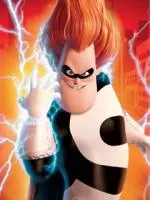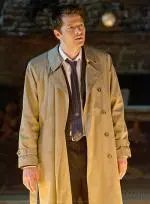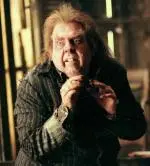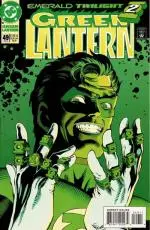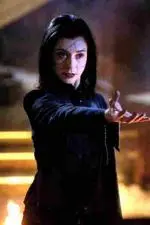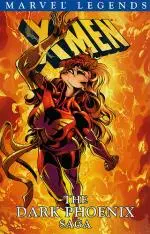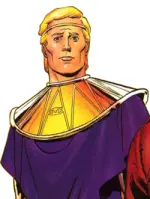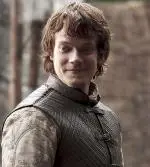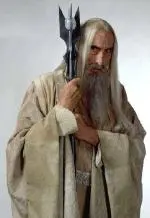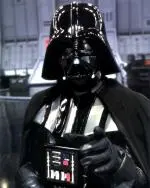Breaking Bad might not be a genre show, but that doesn’t diminish its greatness or my enthusiasm for it. If you haven’t been watching the series, I highly recommend it. One of its main themes is the descent of an ostensibly good man into villainy.
In honor of the imminent end of the series, here is a list of characters from genre fiction who followed a similar descent—who started as decent individuals but soon turned to the, well, Dark Side.
One of the key elements of this kind of story is that villainy rarely occurs without cause. Most of these people begin making choices they think are for the best and these begin to lead them off the moral path. Maybe it’s to save loved ones, maybe it's for their people or their nation or their religion. Sometimes it’s because they have nothing left, because their hatred, primarily for themselves, runs so deeply. For Walter White it was to provide for his family, which seems like a selfless goal.
But in almost all of these cases, there is that moment, what I’ll call the Jane Moment (which should be obvious to Breaking Bad fans). This is the moment where the slippery slope becomes so slippery that the character can’t get free, the point of no return. Not to say that they can’t return, but just that it’s a good measure of when they become the villain.
Here, then, is the list:
![]() 10. Syndrome (The Incredibles)
10. Syndrome (The Incredibles)
The main villain of the movie The Incredibles, Syndrome started out as Buddy Pine, Mr. Incredible’s Number One Fan. Buddy was smart enough to invent his own devices and tried to help Mr. Incredible with his heroic endeavors. Unfortunately, Buddy proved to be more of an impediment than a help and Mr. Incredible rebuffed him.
This was enough to make Pine hate his former hero. As he got older, he started a scheme that would not only take out Mr. Incredible, but all superheroes. He started eliminating them, training his robots in the process, with the idea of taking the place of the heroes once they were gone.
Eventually Mr. Incredible faces him and manages to escape. In the end the combined force of all of The Incredibles (and Frozone) destroy Syndrome's robot and defeat him.
Syndrome’s Jane Moment: The first superhero he kills with his robot. It’s hard to come back from that.
![]() 9. Castiel (Supernatural)
9. Castiel (Supernatural)
Castiel is an interesting case because he starts out as an angel. As an angel he tends to be above board most of the time. But, well, Castiel isn’t your usual angel. As we’ve found out in recent seasons, he’s always been a little different, a little off. Still, he’s the angel who saves Dean from Hell and he’s the one who helps the Winchesters every time they offer up a prayer.
Like most of the others on this list, Castiel starts off having good intentions that get him increasingly mired in bad decisions. He makes a deal with Crowley, leader of Hell, and begins lying to his two closest friends. And then, when he has the opportunity, he absorbs the souls in Purgatory, powering himself up enough to declare himself as the new God. Once again, absolute power corrupts and Castiel becomes something of a tyrant until celestial indigestion sets him back. Seems he absorbed things called Leviathans from Purgatory as well, and they’re nasty creatures. Castiel is able to return the souls to Purgatory, but the Leviathans escape and cause untold death and destruction.
Eventually, Castiel returns, trying to atone for his actions, but it’s a long road back, and there’s clearly been a huge price to pay.
Cas’s Jane Moment: I would argue that Cas making a deal with Crowley doesn’t qualify, nor even his killing Raphael (another angel who wanted to start the apocalypse). All those made a kind of sense. But it was his actions as the new God that put him over the line, killing those he felt were religious hypocrites and destroying Raphael’s followers.
![]() 8. Peter Pettigrew (Harry Potter)
8. Peter Pettigrew (Harry Potter)
Harry Potter’s dad, James Potter, had a bunch of mates that he kicked around with—Sirius Black, Remus Lupin, and Peter Pettigrew. But somewhere along the way Pettigrew fell under the sway of Voldemort, the Harry Potter universe’s Big Bad, and started acting as a double agent. When James and Lily Potter went into hiding, Peter was the one who knew where they were and he betrayed them, leading Voldemort to them. When Voldemort failed to destroy Harry Potter, Peter threw suspicion onto Sirius Black who was believed to have betrayed the Potters for years.
Rowling doesn’t tell us why Pettigrew fell under the sway of Voldemort, but it seems clear that he feared the Dark Lord and decided to throw in with him because he thought the opposition couldn’t win. When Pettigrew is unmasked in the books, Sirius and Lupin try to kill him but Harry shows him mercy. Rather than this reforming Peter, he returns to Voldemort’s service after escaping. Pettigrew never has a true moment of redemption, but later, when he finds Harry Potter in Malfoy Manor, he hesitates before strangling Harry and ultimately that proves his undoing as the replacement silver hand he gained from Voldemort turns and strangles him for his moment of mercy.
Peter’s Jane Moment: Though he had been serving Voldemort for some time, Pettigrew’s Jane Moment has to be when he leads Voldemort to the Potter’s hiding place which results in the death of James and Lily Potter. Don’t forget, Harry, a baby at the time, was supposed to die, too.
![]() 7. Hal Jordan (Green Lantern)
7. Hal Jordan (Green Lantern)
This example from comics is perhaps one of the most controversial. For most of the Silver Age, Hal Jordan WAS Green Lantern. Later, other people took on the Green Lantern role, several of them very successfully (John Stewart, for example), but Hal was the original. Sure he was bland and pretty boring, but he was the guy who helped found the Justice League. He was the guy who received his power ring from the dying Abin Sur.
Well, back in the 90s, DC wanted to shake things up and introduce a whole new Green Lantern to inject some freshness into the series. During the Death of Superman event (which was huge at the time), Mongul, a villain, destroyed GL’s home town of Coast City, killing Hal’s friends and family, his neighbors, everyone.
Hal is noticeably upset and tries to use his power to bring back Coast City. He creates, with his ring, a replacement Coast City, but his power runs out and the Guardians (his intergalactic bosses) get angry with him and summon him to Oa, their homeworld, for a trial.
Hal snaps and heads for Oa to seize the power of the central battery. As other Green Lanterns stand against him, he kills them and takes their power rings. Eventually, he kills the Guardians, too (all save one) and takes the power of the central battery, calling himself Parallax. Only one Guardian, Ganthet, escapes and goes to Earth with the last power ring and gives it to Kyle Rayner who becomes the new Green Lantern.
Later, Hal Jordan, as Parallax, tries to remake the universe in the Zero Hour crossover before he is ultimately defeated. Then, in an attempt at redemption, he sacrifices himself to reignite the sun (really) in Final Night. Later, in further attempts at redemption, Hal Jordan becomes the Spectre and punishes the guilty. Finally, in the 2000s, DC decided to bring Hal back as a hero and retconned that he wasn’t really responsible for his actions and that he had been infected by a fear entity, Parallax, and was nothing more than a puppet. He’s been Green Lantern ever since.
Hal’s Jane Moment: Wallowing in his grief isn’t really that villainous, but Hal Jordan crossed the line when he killed his first Green Lantern. Not only was he a space cop, sworn to protect, but these were his brothers in arms (or at least rings) and he turned on them. It’s a hard line to cross.
![]() 6. Willow (Buffy the Vampire Slayer)
6. Willow (Buffy the Vampire Slayer)
Joss Whedon’s Buffyverse is full of stories of falls and redemption. In fact, three main characters have been through this. I’m almost tempted to discount Angel because he was abruptly transformed into a vampire, then given a soul, then temporarily lost it. A few times. Willow and Faith, however, had more interesting falls. Faith accidentally killed a human which led to a lot of self-loathing which the Mayor of Sunnydale took advantage of. The killing continued. And she took a few shots at Buffy.
Willow was a bit of a different story. Always the good girl, Willow started to go bad when she got hooked on magic. But even as a junkie, Willow was more careless than malevolent. But when her girlfriend, Tara, is killed, Willow not only returns to the mana pipe, she goes full on Dark Willow. Dark Willow flays people alive and kills them, and then almost kills the human race entirely. Luckily, her BFF, Xander, helps to bring her back.
Both characters have recovery in common, and the road to redemption. But it’s a key element of Whedon’s work that power (like that of a Slayer or that of a witch) has the ability to corrupt quite easily.
Willow’s Jane Moment: This would have to be when she flayed Warren alive as he was helpless and restrained.
![]() 5. Jean Grey (X-Men)
5. Jean Grey (X-Men)
Jean Grey, as Marvel Girl, was one of the original X-Men. She was a generally good-natured and low-powered mutant until she was possessed by the cosmic entity, Phoenix. Along with a hefty boost in power came a disregard for life. The power eventually overcomes her, converting her to Dark Phoenix. She defies her former teammates then heads out into space, but when the voyage depletes her energy stores, she replaces them by taking energy from a nearby star. That star then goes supernova, destroying an orbiting planet. A planet with life on it.
Later Phoenix returns to Earth and fights her former teammates until the Shi’ar come looking for her because of the danger she poses. The X-men first fight the Shi’ar, but then try to subdue Jean before the Shi’ar take the extreme measure of destroying the whole solar system. Jean eventually comes to her senses and sacrifices herself on the moon (yes, on the moon).
Later, Jean returns to life, this time separated from the Phoenix Force, but she’s since died again.
Jean’s Jane Moment: The genocide of a whole race of aliens.
![]() 4. Veidt/Ozymandias (Watchmen)
4. Veidt/Ozymandias (Watchmen)
This is another case of a superhero falling from grace. Or maybe not falling from grace, since Ozymandias thinks he is being the hero. The best villains think that they’re in the right, of course, or at least justified in their actions like Walter White. In Veidt’s case, he believes that the ends justify the means. He sees the inevitability of nuclear war and determines the the only way to prevent it is to unite humanity against a common, external threat. To that end, he biologically engineers an entity to stand in for an alien. Of course, when The Comedian learns what Veidt has planned, Veidt kills him, kicking off the events of Watchmen.
Veidt isn’t squeamish about a big body count, either. He tries to remove many of his former teammates and is willing to sacrifice thousands of people in his manufactured event for the so-called greater good. In the end, Dr. Manhattan, Nite-Owl and Silk Spectre remain quiet about the truth of what happened because the plan seems to have worked. Only Rorschach refuses to go along with it and pays the ultimate price.
Veidt’s Jane Moment: Killing The Comedian, which ultimately led to a lot more killing and covering up.
![]() 3. Theon Greyjoy
3. Theon Greyjoy
Whether you read A Song of Ice and Fire or watch A Game of Thrones, one thing is clear—Theon Greyjoy is a despicable human being. But he didn’t start out that way. Theon, in at least some small part, is a victim of his society (like most of the characters in George R. R. Martin’s story). Because of his father’s actions, he became a hostage, the way sons of conquered enemies often did. By all accounts he was treated well by Ned Stark, almost like one of the Stark boys (or at least the bastard, Jon Snow). Still, Theon was always aware that he wasn’t a Stark, that he was technically a hostage, and that, along with the need for his real father’s approval, planted a seed that began to grow into quite the carnivorous plant. In this case the need for Daddy’s approval led to anger, which led to hate, and so on. And Theon causes quite the bit of suffering. Of course, Theon starts to experience payback, and perhaps even remorse, but he firmly hits villainy before that happens.
Theon’s Jane Moment: I could name a few different moments, but I think when he kills two innocent boys that’s probably one of the worst. Even worse than killing kids, he makes everyone believe that those kids are Bran and Rickon Stark.
![]() 2. Saruman (The Lord of the Rings)
2. Saruman (The Lord of the Rings)
We don’t get to see a lot of Saruman in The Lord of the Rings before he turns on Gandalf. But originally Saruman was one of the Istari, like Gandalf, powerful beings sent to Middle Earth to guard it. Saruman was the greatest of the order, which apparently entitled him to wear the White Robes. Continuing with the theme of power corrupting, Saruman has a palantir which puts him in touch with Sauron, and he thinks that Sauron’s victory is unavoidable. He would rather be in league with power than fail, so he flips sides. All the while, of course, he lusts after the Ring of Power himself, hoping to claim it and become the supreme power in Middle Earth.
Saruman causes quite a bit of trouble, breeding new kinds of orcs, tearing up Fangorn forest, and meddling in Rohan before Merry, Pippin and the Ents take him down. To put the cap on things, Gandalf breaks his staff and takes away his power (by this time Gandalf gets to wear the spiffy white robes). Even defanged, though, Saruman is dangerous, which he proves by taking over The Shire. Unlike many of the other characters on this list, Saruman never has a redeeming moment, and in fact continues his evil even as his power fades. It only ceases when his servant, Grima, cuts his throat.
Saruman’s Jane Moment: This example is a little less obvious. Imprisoning Gandalf is a big thing, if using the palantir isn’t. But I think his sending his own breed of orcs into Rohan is perhaps a bigger turning point. He is responsible for Theomer’s death, then. And this subsequently helps him get his claws into the grief-stricken Theoden.
![]() 1. Darth Vader (Star Wars)
1. Darth Vader (Star Wars)
Perhaps the poster child for this idea, six movies (and numerous other works) have been devoted to the story of Anakin Skywalker’s fall and his conversion to one of the most iconic villains in film, Darth Vader. Anakin’s conversion is handled a bit clumsily in the movies (to put it nicely), but he starts out firmly as a “good guy,” albeit one with a bad streak.
The idea of “the fall” is inherent to the Star Wars universe. We’re told that the Dark Side is seductive. That it seems attractive because it’s easier. All it takes is a little hate and you can start down the road to the Dark Side. As Yoda says, “Fear leads to anger, anger leads to hate, hate leads to suffering.” But the Dark Side is also powerful, and as we’ve seen on this list, power corrupts. Vader takes a step toward redeeming himself by killing the Emperor and saving Luke on the second Death Star, but he has an awful lot of blood on his hands.
Vader’s Jane Moment: It has to be when he, as Anakin, kills a bunch of Jedi kids. I mean, kids.
So that’s my list. Have any others to add? People you would remove? Different Jane Moments to suggest? Please do so in the comments.

About the author
Rajan Khanna is a fiction writer, blogger, reviewer and narrator. His first novel, Falling Sky, a post-apocalyptic adventure with airships, is due to be released in October 2014. His short fiction has appeared in Lightspeed Magazine, Beneath Ceaseless Skies, and several anthologies. His articles and reviews have appeared at Tor.com and LitReactor.com and his podcast narrations can be heard at Podcastle, Escape Pod, PseudoPod, Beneath Ceaseless Skies and Lightspeed Magazine. Rajan lives in New York where he's a member of the Altered Fluid writing group. His personal website is www.rajankhanna.com and he tweets, @rajanyk.
